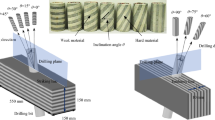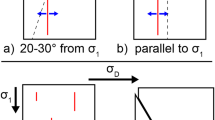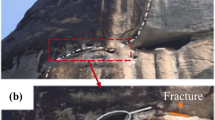Abstract
We investigate how a highly elliptical and mechanically rigid clast embedded in an infinite rock mass respond to the far-field stresses. The numerical analysis is carried out on elliptical clasts with aspect ratios ranging from 13.5 to 58.5, oriented at a right angle to the maximum far-field stress. A 2D plane strain model has been adopted to decipher the states of stress inside elliptical clasts. We argue that the tensile stress within the clasts gets enhanced and develops systematic mode-I (tensile) fractures within it as the far-field stress increases. We conclude that the intra-clast tensile stress decreases with increasing clast ellipticity, i.e., tensile fractures develop more easily within clasts with higher aspect ratios (~>20) while a higher far field tensile stress is required to fracture clasts with lower aspect ratios. We also interpret that stress enhancement is independent of the clast area and inter-focii distance of the clast, whilst the aspect ratio of the clast is found to be crucial for the development of tensile fractures within the elliptical clast for a constant material property.






Similar content being viewed by others
REFERENCES
S. S. Acharyya and T. K. Mondal, “Stress enhanced tensile fractures in elliptical clast in conglomerate,” J. Struct. Geol. 122, 81‒88 (2019). https://doi.org/10.1016/j.jsg.2019.02.001
J. Angelier and B. Colletta, “Tension fractures and extensional tectonics,” Nature 30, 49–51 (1983).
M. Antonellini, L. D. Sole, and P. N. Mollema, “Chert nodules in pelagic limestones as paleo-stress indicators: 3D geomechanical analysis,” J. Struct. Geol. 132, 103‒979 (2020). https://doi.org/10.1016/j.jsg.2020.103979
A. Aydin, “Fractures, faults, and hydrocarbon entrapment, migration and flow,” Mar. Petrol. Geol. 17 (7), 797–814 (2000). https://doi.org/10.1016/S0264-8172(00)00020-9
S. Bergbauer and S. J. Martel, “Formation of joints in cooling plutons,” J. Struct. Geol. 21 (7), 821‒835 (1999). https://doi.org/10.1016/S0191-8141(99)00082-6
S. Bergbauer, S. J. Martel, and C. F. Hieronymus, “Thermal stress evolution in cooling pluton environments of different geometries,” Geophys. Res. Lett. 25 (5), 707–710 (1998). https://doi.org/10.1029/98GL00047
J. G. Crider, “The initiation of brittle faults in crystalline rock,” J. Struct. Geol. 77, 159–174 (2015). https://doi.org/10.1016/j.jsg.2015.05.001
A. Eidelman and Z. Reches, “Fractured Clasts—A new stress indicator,” Geology 20, 307–310 (1992). https://doi.org/10.1130/0091-7613(1992)020<0307:FPANSI>2.3.CO;2
J. D. Eshelby, “The determination of the elastic field of an ellipsoidal inclusion, and related problems,” Proc. R. Soc. London, Ser. A 241, 376–395 (1957). https://doi.org/10.1098/rspa.1957.0133
E. Flodin and A. Aydin, “Faults with asymmetric damage zones in sandstone, Valley of Fire State Park, southern Nevada,” J. Struct. Geol. 26 (5), 983‒988 (2004). https://doi.org/10.1016/j.jsg.2003.07.009
J. C. Jaeger, N. G. W. Crook, and R. W. Zimmerman, Fundamentals of Rock Mechanics (Blackwell Publ. Ltd., NY, USA, 2007).
T. W. Lambe and R. V. Whitman, Soil Mechanics (Wiley, NY, USA, 1969).
S. E. Laubach, J. Lamarche, B. D. M. Gauthier, et al., “Spatial arrangement of faults and opening-mode fractures,” J. Struct. Geol. 108, 2‒15 (2018). https://doi.org/10.1016/j.jsg.2017.08.008
R. N. McGinnis, D. A. Ferrill, A. P. Morris, et al., “Mechanical stratigraphic controls on natural fracture spacing and penetration,” J. Struct. Geol. 95, 160–170 (2017). https://doi.org/10.1016/j.jsg.2017.01.001
T. K. Mondal and S. S. Acharyya, “Fractured micro-granitoid enclaves: a stress marker,” J. Struct. Geol. 113, 33–41 (2018). https://doi.org/10.1016/j.jsg.2018.05.011
T. K. Mondal and M. A. Mamtani, “3-D Mohr circle construction using vein orientation data from Gadag (Southern India) region—implications to recognize fluid pressure fluctuation,” J. Struct. Geol. 56, 45‒56 (2013). https://doi.org/10.1016/j.jsg.2013.08.005
T. K. Mondal, S. Bhowmick, S. Das, et al., “Paleostress field reconstruction in the western Dharwar Craton, south India: Evidences from brittle faults and associated structures of younger granites,” J. Struct. Geol. 135, Art.104040 (2020). https://doi.org/10.1016/j.jsg.2020.104040
J. Olson and D. D. Pollard, “Inferring paleostresses from natural fracture patterns: A new method,” Geology 17 (4), 345–348 (1989). https://doi.org/10.1130/0091-7613(1989)017<0345:IPFNFP>2.3.CO;2
J. G. Ramsay, Folding and Fracturing of Rocks (McGraw-Hill, NY, USA, 1967).
J. M. Ramsey and F. M. Chester, “Hybrid fracture and the transition from extension fracture to shear fracture,” Nature 428, 63‒66 (2004). https://doi.org/10.1038/nature02333
J. G. Ramsay and M. I. Huber, The Techniques of Modern Structural Geology, Strain Analysis (Acad. Press, London, UK, 1983).
K. Sato, A. Yamaji, and S. Tonai, “Parametric and non-parametric statistical approaches to the determination of paleostress from dilatant fractures: application to an Early Miocene dike swarm in Central Japan,” Tectonophysics 588, 69–81 (2013). https://doi.org/10.1016/j.tecto.2012.12.008
P. Segall, E. H. McKee, S. J. Martel, et al., “Late Cretaceous age of fractures in the Sierra Nevada batholith, California,” Geology 18 (12), 1248‒1251 (1990). https://doi.org/10.1130/0091-7613(1990)018<1248:LCAOFI>2.3.CO;2
R. H. Sibson, “Earthquake rupturing as a mineralizing agent in hydrothermal systems,” Geology 15 (8), 701–704 (1987). https://doi.org/10.1130/0091-7613(1987)15<701:ERAAMA>2.0.CO;2
ACKNOWLEDGMENTS
The author Paramita Das acknowledges Indian Statistical Institute for Visiting Scientist research grant. She thanks Dr. Shiladri S. Das (Indian Statistical Institute, Kolkata, India) for providing the logistic supports. The authors are grateful to Sreyashi Bhowmick (Tel Aviv University International, Tel Aviv, Israel). The authors are thankful to anonymous reviewers for helpful comments and to Editor M.N. Shoupletsova (Geological Institute of Russian Academy of Sciences, Moscow, Russia) for thorough editing the manuscript.
Funding
This work was supported by Indian Statistical Institute research grant to Tridib Kumar Mondal.
Author information
Authors and Affiliations
Corresponding author
Ethics declarations
The authors of this work declare that they have no conflicts of interest.
Additional information
Publisher’s Note.
Pleiades Publishing remains neutral with regard to jurisdictional claims in published maps and institutional affiliations.
Supplementary Information
Rights and permissions
About this article
Cite this article
Das, P., Acharyya, S.S., Mondal, T.K. et al. Evaluating Tensile Fractures in Rigid Clasts with Very High Aspect Ratio. Geotecton. (2024). https://doi.org/10.1134/S0016852124700080
Received:
Revised:
Accepted:
Published:
DOI: https://doi.org/10.1134/S0016852124700080




